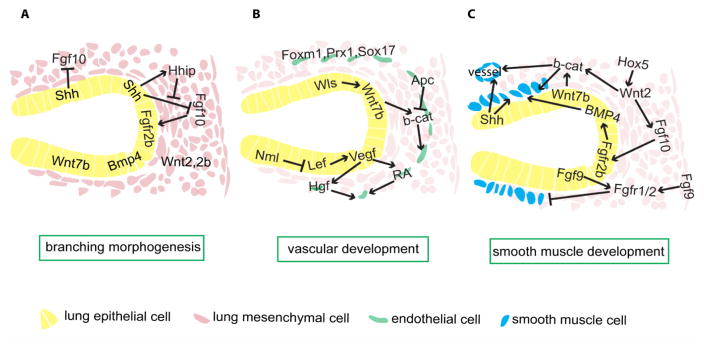Figure 4.
Mesenchymal-epithelial crosstalk directing branching and mesenchymal differentiation into vasculature and smooth muscle cells. A) Several signals direct branching and proximal-distal patterning in lung endoderm. Submesothelial Fgf10 signals to the nearby distal epithelium, inducing new branching formation. Shh is expressed in the epithelium and is enriched in the distal tip. Shh inhibits Fgf10 expression, while at the distal tip, high Shh signaling activates Hhip expression, which in turn sequesters Shh ligand, thus protecting Fgf10 expression at the distal tip. Bmp4 appears to have autocrine inhibitory effects on budding. Wnt signals, activated by mesenchymal Wnt2/2b and epithelial Wnt7b, cooperate with Fgf10 to promote branching morphogenesis. B) Vegf, which is gradually restricted to the distal epithelium, promotes vasculature development, partly through supporting RA and Hgf signals in endothelial cells. The Wnt pathway appears to have multiple functions supporting vasculature formation. Epithelial Wnt ligands are critical during this process; Wnt activity in the epithelium is indicated to promote Vegf signaling, while Wnt signaling in endothelial cells is required for endothelial cell maturation. Other important endothelial autonomous transcription factors include Foxm1, Prx1 and Sox17. C) Wnt2 and Wnt7b, through effector β-cat, promote smooth muscle differentiation from multipotent mesenchymal cells, while Hox5 appears to be upstream of Wnt signaling. Fgf10 appears downstream of Wnt2, marks SMC progenitors, and is also required for SMC development, potentially through upregulation of epithelial Bmp4. Fgf9, from epithelial and mesothelial cells, signals through mesenchymal Fgfr1/2 and prevents SMC differentiation distally. Additionally, Shh is required for both airway and vascular SMC development.

